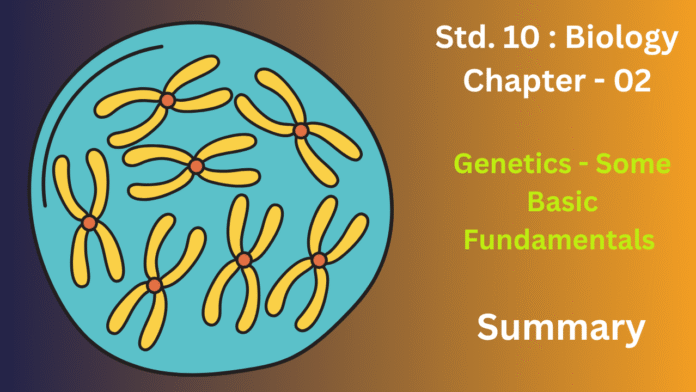The chapter “Genetics – Some Basic Fundamentals” from the ICSE 10th Board Biology textbook introduces the foundational concepts of heredity and variation. It essentially explains how traits are passed from parents to offspring and why individuals within a species aren’t identical.
You’ll learn about key terms like heredity, which is the transmission of characteristics, and variations, which are the differences among individuals. The chapter then delves into genes as the basic units of heredity, located on chromosomes within the nucleus of a cell.
A significant portion is dedicated to Mendel’s experiments and his laws of inheritance. You’ll encounter concepts like dominant and recessive alleles, which determine how traits are expressed. You’ll also learn about homozygous (having two identical alleles for a trait) and heterozygous (having two different alleles).
The use of Punnett squares is introduced as a tool to predict the probable outcomes of genetic crosses, helping to visualize how different combinations of alleles can lead to specific phenotypes. Finally, the chapter touches upon the importance of genetics in understanding human traits, genetic disorders, and the broader field of biotechnology. It lays the groundwork for understanding more complex genetic principles in higher studies.
A. MULTIPLE CHOICE TYPE: (Select the most appropriate option)
1) Which one of the following has the smallest number of chromosomes?
(a) Onion
(b) Mouse
(c) Monkey
(d) Ascaris
Ans: (d) Ascaris
2) Which one of the following is the phenotypic monohybrid ratio in F2 generation?
(a) 3:1
(b) 1:2:1
(c) 2:2
(d) 1:3
Ans: (a) 3 : 1
B: VERY SHORT ANSWER TYPE
1) Match the terms in column I with their explanations in column II.
Ans:
| column I | column II |
| a. Genetics | (iii) Study of laws of inheritance of characters |
| b. Autosomes | (v) Chromosomes other than the pair of sex chromosomes |
| c. Recessive gene | (iv) A gene that can express when only in a similar pair |
| d. Allele | (ii) The alternative forms of a gene |
| e. Homologous chromosomes | (i) Chromosomes similar in size and shape |
2) Name two animals which have nineteen pairs of chromosomes.
Ans: Domestic cats (Felis catus) have 19 pairs of chromosomes, totaling 38 in their somatic cells. Red foxes (Vulpes vulpes) surprisingly share this same count, also possessing 19 pairs or 38 chromosomes. This identical chromosome number is noteworthy despite their different family classifications (cats are Felidae, foxes are Canidae).
3) Name any two genes in humans.
Ans: Cystic Fibrosis (CF) is a genetic disorder that mainly affects the lungs and pancreas. It’s caused by a defective gene, leading to thick, sticky mucus that clogs airways and pancreatic ducts. This causes breathing problems, frequent lung infections, and difficulty digesting food. While there’s no cure, current treatments help manage symptoms and improve quality of life.
Huntington’s Disease (HD) is a progressive, inherited neurodegenerative condition caused by a genetic defect on chromosome 4. This defect results in an abnormal huntingtin protein that damages brain cells, especially those controlling movement, thought, and mood. Symptoms, usually appearing in mid-life, include involuntary movements (chorea), cognitive decline affecting memory and judgment, and psychiatric issues. As HD advances, individuals lose the ability to walk, speak, and swallow. Currently, there’s no cure, with treatments focused on symptom management, though research continues to seek ways to halt or slow its progression.
4) Which one of the following genotypes is homozygous dominant and which one homozygous recessive in regards to tongue rolling: Rr, rr, RR
Ans: Homozygous dominant – RR
Homozygous recessive – rr
C. SHORT ANSWER TYPE:
1) Differentiate between:
(a) genotype and phenotype.
(b) character and trait.
(c) monohybrid and dihybrid cross (phenotypic ratio)
Ans: a)The genotype can be thought of as the organism’s complete, inherited genetic blueprint. It encompasses the entire collection of genes, the specific sequence of DNA that acts as the detailed instruction manual for building and operating that particular individual. Imagine a comprehensive cookbook containing every single recipe a chef will ever use, meticulously written out with precise ingredients and preparation steps. This cookbook, with all its inherent instructions, is analogous to the genotype. It’s the underlying code, the potential, the set of instructions passed down from one generation to the next. This genetic information, residing within the chromosomes of every cell, dictates everything from the color of one’s eyes to their predisposition to certain traits or even diseases. It’s a static entity, inherited at conception, and remains largely unchanged throughout an organism’s life.
In contrast, the phenotype is the observable manifestation of that genetic blueprint. It’s the outward expression of the genotype, the actual characteristics and traits that we can see, measure, or otherwise detect. Carrying our cookbook analogy forward, the phenotype is the actual dish that emerges from following the recipes. It’s not just the ingredients listed, but the cooked meal itself – its aroma, its taste, its texture, its presentation. For a living organism, the phenotype encompasses physical attributes like height, hair color, and body shape, but also extends to physiological characteristics such as blood type, metabolic rates, and even behavioral patterns. Environmental factors play a significant and often profound role in shaping how those genetic instructions are ultimately expressed. For example, a plant with the genetic potential for tall growth (its genotype) might remain stunted if it doesn’t receive adequate sunlight and nutrients (environmental influences). Similarly, human health and development are a complex interplay between inherited genes and lifestyle choices, diet, and exposure to various environmental conditions. Therefore, while the genotype provides the fundamental instructions, the phenotype represents the dynamic outcome of those instructions interacting with the world around them.
b)At its heart, a character is the complete, living entity within a story—be it a person, an anthropomorphic animal, a mythological creature, or even a personified object or abstract idea. They are the actors through whom the narrative unfolds, the individuals who breathe life into the plot, explore the story’s themes, and navigate its conflicts. A character isn’t merely a name or a description; they are the sum total of their being within the fictional world. This includes their name, their designated role in the narrative, their entire backstory, the web of relationships they form with others, and every single quality that collectively defines them. Characters are the driving force behind the narrative; they experience personal growth, confront challenges, and interact with both their environment and fellow characters, thus pushing the story relentlessly forward.
Conversely, a trait is a specific, individual quality, characteristic, or attribute that contributes to the definition of a character. Think of traits as the building blocks of a character’s identity. They are the discrete components that form a character’s personality, their physical appearance, or their habitual behaviors. When we describe a character as “brave,” “loyal,” or “quick-witted,” we are highlighting their personality traits. Describing them as having “piercing blue eyes” or “a limp” refers to their physical traits. And noting that they are “always late” or “tend to fidget” speaks to their behavioral traits. A single character can possess a multitude of traits, some of which might even appear contradictory, adding layers of depth, complexity, and realism to their portrayal. It’s these often conflicting traits that make characters feel more human and less like one-dimensional archetypes.
c) When two parents heterozygous for this trait are crossed, their offspring (F2 generation) typically show a 3:1 phenotypic ratio, meaning three display the dominant trait for every one showing the recessive trait.
Conversely, a dihybrid cross tracks the inheritance of two distinct traits simultaneously, such as seed color and shape in pea plants. Crossing two individuals heterozygous for both traits results in an F2 phenotypic ratio of 9:3:3:1. This ratio reflects the independent assortment of alleles, with nine offspring showing both dominant traits, three showing one dominant and one recessive, another three showing the other dominant and recessive combination, and one displaying both recessive traits.
2) Among lion, tiger and domestic cat, all the three have the same number of 38 chromosomes, yet they have different appearances. How do you account for such differences?
Ans: Despite having the same number of chromosomes (38), lions, tigers, and domestic cats exhibit diverse appearances due to differences in their genes and the regulation of those genes. While the chromosome count is identical, the specific sequence of DNA within those chromosomes, the arrangement of genes, and how those genes are expressed (turned on or off, and to what extent) vary significantly. These genetic variations dictate traits like fur pattern, size, body structure, and even behavioral tendencies, leading to their distinct appearances.
3) List any three features of garden pea with their dominant and recessive traits.
Ans: Here are three features of garden peas with their dominant and recessive traits:
- Seed Shape: Dominant – Round; Recessive – Wrinkled
- Pod Colour: Dominant – Green; Recessive – Yellow
- Flower Position: Dominant – Axial; Recessive – Terminal
4) Explain why generally only the male child suffers from colour blindness and not the female?
Ans:Color blindness is more prevalent in males because it’s an X-linked recessive trait. Females have two X chromosomes, allowing a healthy X to compensate for a faulty one. Males, with only one X chromosome, will express color blindness if that single X carries the gene, as there’s no backup X to mask it.
5) In a certain species of animals, black fur (B) is dominant over brown fur (b) Show the possible ratio of genotypes and phenotypes of the offspring of the pure breeding different coloured parents.
Ans:The given phenotypic ratio of 3 (Black Fur) : 1 (Brown Fur) and genotypic ratio of 1 (Homozygous Black Fur) : 2 (Heterozygous Black Fur) : 1 (Homozygous Brown Fur) are the classic results of a monohybrid cross where one allele (black fur) is completely dominant over another (brown fur). These ratios typically emerge from a cross between two heterozygous individuals (e.g., Bb x Bb), demonstrating Mendelian inheritance patterns of dominance and segregation.
D. LONG ANSWER TYPE
1) Explain the following terms:
(a) heterozygous
(b) Homozygous
(c) pedigree chart.
Ans: a) Heterozygous
When an individual is heterozygous for a trait, it means they have two different versions (alleles) of a gene for that particular characteristic. Think of it like having one blue eye gene and one brown eye gene. Even if one allele’s trait is visible (like brown eyes being dominant), the individual still carries the “hidden” or recessive allele. This is important because they can pass on either allele to their children.
b) Homozygous
An individual is homozygous for a trait when they have two identical versions (alleles) of a gene. This is like having two blue eye genes or two brown eye genes. In this case, there’s no hidden allele; their genetic makeup directly matches the observable trait. Homozygous individuals will consistently pass on that specific allele to their offspring, making inheritance patterns very predictable for that trait.
c)Pedigree Chart
A pedigree chart is a visual family tree that geneticists use to track how specific traits, conditions, or diseases are inherited across multiple generations. Lines connect parents to children, revealing inheritance patterns. By analyzing these charts, experts can determine if a trait is dominant or recessive, and predict the likelihood of future generations inheriting it.
2) State the three mendel’s laws of inheritance.
Ans: Law of Segregation: During the formation of gametes (sperm or egg cells), the two alleles for a heritable character separate from each other, so each gamete receives only one allele.
Law of Independent Assortment: The Law of Independent Assortment, a core principle in genetics, states that alleles for different genes separate independently during gamete formation. This means the inheritance of one gene’s trait doesn’t influence another’s. For example, a plant’s flower color allele (red or white) assorts independently of its seed shape allele (round or wrinkled) when producing sperm or egg cells. This independence, similar to shuffling two separate card decks, leads to diverse genetic combinations in offspring, essential for genetic variation and evolution. Gregor Mendel’s discovery of this law, along with the Law of Segregation, debunked blending inheritance and laid the groundwork for modern genetics.
Law of Dominance: In a heterozygote, one allele (the dominant allele) will express itself exclusively, masking the effect of the other allele (the recessive allele).
3) Does the sex of the child depend on the father or it is just a matter of chance? Discuss
Ans: The father determines a child’s sex. Females always contribute an X chromosome, while males contribute either an X or a Y. If the father’s sperm carries an X, the child will be female (XX); if it carries a Y, the child will be male (XY).
E. STRUCTURED / APPLICATION AND SKILL TYPE:
1) In a certain species of animals, black fur (B) is dominant over brown fur (b) Predict the genotype and phenotype of the offspring when both parents are ‘Bb’ or have heterozygous black fur.
Ans: When two heterozygous black-furred parents (Bb) breed, their offspring exhibit a genotypic ratio of 1 BB : 2 Bb : 1 bb. This translates to a phenotypic ratio of 3 black-furred individuals for every 1 brown-furred individual.
2) Two pairs (A & B) of rabbits were crossed as given below:
(a) Can you tell which coat colour (black or white) is dominant? ………………………..
(b) Is the coat colour sex-linked? …………………..
Ans: (a) Black (b) No
3) Make a punnett square for finding out the proportion of different genotypes in the progeny of a genetic cross between.
(a) A pure tall (TT) pea plant with a pure dwarf (tt) pea plant.
(b) red flower variety of pea (RR) with white flower variety of pea (rr)
Ans: (a) Pure Tall (TT) x Pure Dwarf (tt) Pea Plants:
When a pure tall pea plant (TT) is crossed with a pure dwarf pea plant (tt), all the offspring in the first generation (F1) will have the genotype Tt. This means 100% of them will be heterozygous and will exhibit the tall phenotype, as the tall allele (T) is dominant.
(b) Red Flower (RR) x White Flower (rr) Pea Plants:
Similarly, crossing a red flower pea plant (RR) with a white flower pea plant (rr) results in all F1 offspring having the genotype Rr. Consequently, 100% of these plants will be heterozygous and will display red flowers, due to the dominance of the red allele (R).
In both cases, these monohybrid crosses clearly illustrate the principle of dominance, where the dominant allele’s trait is expressed in the heterozygous condition, completely masking the recessive trait.
4) A family consists of two parents and their five children and the pedigree chart below shows the inheritance of the trait colour blindness in them.
(a) Who is colour blind in the parents – the Father or the Mother?
Ans: Based on the provided pedigree chart, we can systematically analyze the symbols to definitively identify which parent is colorblind. Pedigree charts utilize a standardized set of symbols to represent individuals and the presence or absence of a particular trait within a family.
Here’s a breakdown of the standard symbols and their application to this chart:
- Squares: In genetics, squares are universally used to represent male individuals.
- Circles: Circles, on the other hand, denote female individuals.
- Shaded Shapes: A filled or shaded shape (in this case, blue) signifies that the individual expresses the genetic trait being studied. In this specific scenario, the shaded shapes indicate individuals who are colorblind.
- Unshaded Shapes: Conversely, an unshaded or unfilled shape indicates that the individual does not express the trait in question.
Now, let’s apply this understanding to the uppermost row of the pedigree chart, which represents the parental generation:
- The Male Parent (Father): On the left side of the top row, we observe a square that is filled in with blue. As per the conventions, a shaded square means that this male individual expresses the trait. Therefore, it can be conclusively determined that the father is colorblind.
- The Female Parent (Mother): On the right side of the top row, there is a circle that is unshaded (white). According to the established symbols, an unshaded circle indicates a female individual who does not express the trait.
In conclusion, by carefully interpreting the standard symbols of the pedigree chart, we can definitively state that the father is the parent who is colorblind. The mother does not exhibit the trait of color blindness.


